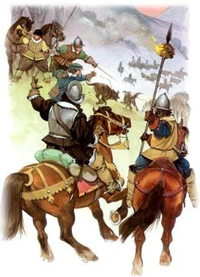
|
|
|
|
|

There were several Jameson families said to have been in the Middle Marches of this border region, mostly on the English side of the border in the Upper North Tyne River area. Jameson families can also be found on the Scottish side of the border, mainly in the Kelso area of Roxburghshire. As such, they were very likely Reivers and undoubtedly considered a clan by traditions of that area and time. Lowland clans were different from Highland clans, somewhat more based around individual families but with less structure and none of the grandiose we know and associate with the Highland clans. The repopulation of Ulster, Ireland, particularly the area of County Antrim, starting in the early 1600's, was done, in part, with many families from the Border area of both England and Scotland. This was a deliberate effort to help reduce the historical difficulties in this entire region. The banishment of many so called 'convicts' to Australia and South Africa in the eighteenth century, was also made with many from this area for those same reasons. The history of this area is rich in its descriptions of many of their people, their life and their conflicts, all of which is well documented elsewhere. As this is not intended to be a history of the Border regions, the interested reader is urged to separately seek out these colorful stories.
- please contact us regarding any broken links - or to suggest or submit further content. |
